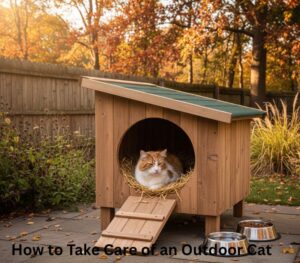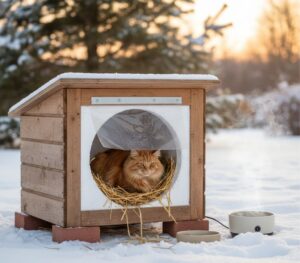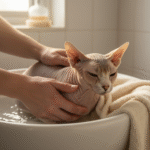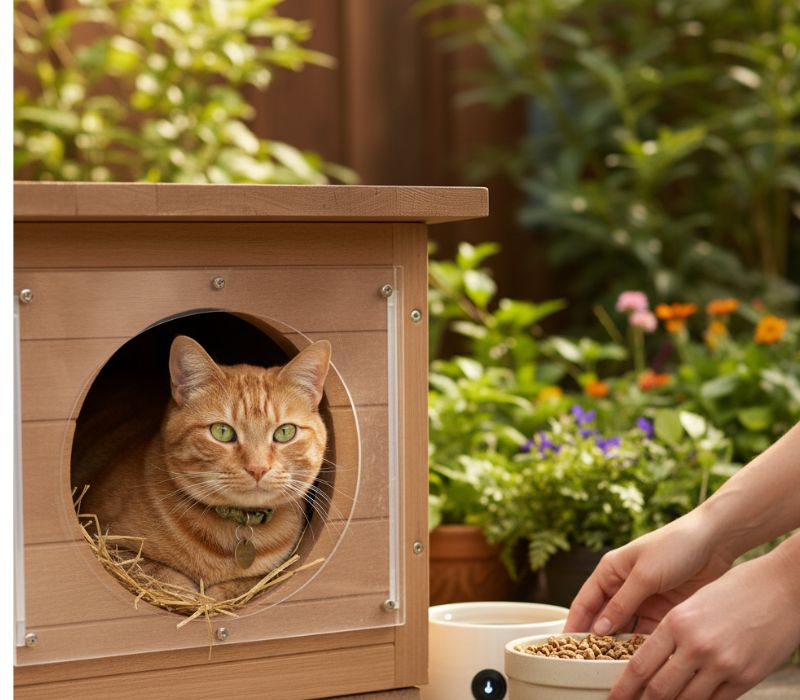Wondering how to take care of an outdoor cat? This easy guide covers everything from proper shelter and nutrition to vet care, safety, and keeping your feline friend comfortable in every season.
Mastering the Art of How to Take Care of an Outdoor Cat
Caring for an outdoor cat presents a unique set of responsibilities that differ significantly from caring for an indoor companion. These resilient, adventurous spirits thrive when they have the freedom to explore, but that very freedom exposes them to greater risks. As their caretaker, you are the crucial link between their wild instincts and their need for domestic security, comfort, and health.
The commitment you make to your outdoor feline friend must be thorough, blending respect for their independence with diligent attention to their physical safety and well-being. This guide delves into every critical aspect of how to take care of an outdoor cat, ensuring you provide a holistic environment that allows them to flourish. From the basic necessities of life—shelter and sustenance—to the proactive measures of health and safety, we will break down the care regimen into actionable, understandable steps.
We will systematically cover ten fundamental pillars of outdoor cat care. We will explore how to take care of an outdoor cat by creating a safe haven, securing their identity, maintaining peak health through veterinary care, and even addressing their impact on local wildlife. Preparing yourself with this knowledge ensures you’re ready for the commitment. Are you ready to provide your adventurous companion with the safest, healthiest, and happiest life possible? Let’s dive into the specifics of how to take care of an outdoor cat.
How to Take Care of an Outdoor Cat: Providing a Safe and Secure Sanctuary
The single most urgent need for any outdoor cat is a reliable place to escape the elements. Their thick fur is not enough to withstand prolonged exposure to driving rain, snow, or extreme temperatures. Providing proper shelter is a foundational step in understanding how to take care of an outdoor cat.
Provide Shelter: Ensuring Warmth, Safety, and Protection
An ideal outdoor cat shelter must meet three criteria: it must be warm, waterproof, and insulated. Simply putting a blanket under a porch won’t suffice; damp bedding quickly becomes dangerously cold.
Constructing the Perfect Cat Hideaway:
- Use Appropriate Materials: A sturdy plastic tote or a wooden structure are excellent starting points. Avoid cardboard, which absorbs moisture and quickly deteriorates.
- Insulation is Key: Use Styrofoam sheets or straw (not hay!) to line the walls, floor, and ceiling. Straw repels moisture and is easily fluffed, creating warm pockets of air. Never use blankets or towels, as they absorb body heat and hold moisture, which is life-threatening in cold weather.
- Create a Windbreak Entry: The entrance should be small—just large enough for the cat—and preferably covered with a heavy, flexible plastic flap. This keeps out wind, rain, and snow. Ideally, have the entrance face a structure, like a wall or fence, to minimize wind exposure.
- Raise it Off the Ground: Elevate the shelter slightly (using bricks or wooden blocks) to prevent water from seeping in from the bottom and to provide a barrier against the cold ground.
- Location, Location, Location: Place the shelter in a quiet, discreet spot away from high-traffic areas and facing away from the prevailing wind.
Taking the time to build or purchase a well-insulated, weatherproof dwelling demonstrates your profound commitment to how to take care of an outdoor cat through all seasons.
Fresh Food and Water: Essential Daily Sustenance for How to Take Care of an Outdoor Cat
An outdoor cat expends more energy than an indoor one, especially regulating body temperature, meaning their caloric needs are often higher. Their diet must be high-quality and reliable.
The Crucial Role of Nutrition and Hydration:
- Offer High-Quality Food Daily: Feed your cat a high-quality, protein-rich dry or wet food once or twice a day. Dry food is generally preferred for outdoor feeding as it doesn’t spoil as quickly in warm weather.
- Monitor Portions: Free-feeding (leaving a full bowl out all day) can attract pests and wildlife. Instead, offer meals at set times.
- Water is Non-Negotiable: Access to clean, fresh water is paramount. In freezing temperatures, this becomes a life-or-death issue. Use ceramic or insulated bowls, or consider a heated water bowl (designed for pets) to prevent freezing. Check the water source multiple times a day during extreme weather, whether it’s scorching hot or freezing cold.
Understanding the increased energy demands is an integral part of how to take care of an outdoor cat.
Health and Identification: The Proactive Measures
While providing shelter and food meets their immediate needs, a proactive approach to health and identification secures their future. These steps safeguard your cat against disease, prevent overpopulation, and ensure a quick reunion if they wander.
Regular Veterinary Care: The Shield Against Disease
Outdoor cats are inherently exposed to more parasites, contagious diseases, and potential injuries. Consistent veterinary care isn’t a luxury; it’s a core responsibility of how to take care of an outdoor cat.
A Year-Round Health Checklist:
- Vaccinations are Vital: Core vaccines (like Rabies and FVRCP – Feline Viral Rhinotracheitis, Calicivirus, Panleukopenia) are essential to protect your cat and your community.
- Parasite Prevention: Deworming and robust flea/tick prevention must be maintained year-round. Heartworm prevention is also critical, as mosquitoes can transmit the disease outdoors. Consult your vet for the best prescription products.
- Annual Checkups: Even if your cat seems fine, an annual or semi-annual physical examination allows a veterinarian to catch subtle signs of illness, kidney issues, dental problems, or hidden injuries early on.
Microchip and ID Tag: The Essential Redundancy System
Many outdoor cats don’t tolerate collars, but a microchip is a permanent, secure form of identification that significantly boosts the chance of being reunited if they get lost.
- The Power of the Microchip: A microchip is about the size of a grain of rice and is implanted quickly and painlessly under the cat’s skin. Crucially, you must keep your contact information updated with the microchip registry. A microchip with outdated information is useless.
- ID Tag and Collar: While not all cats accept a collar, one with a clear ID tag and your current phone number is the fastest way for a neighbor or rescuer to contact you. Use a breakaway collar specifically designed for cats; this is non-negotiable, as it prevents strangulation if the collar gets snagged on a branch or fence.
These identification steps are the insurance policy for how to take care of an outdoor cat’s safety.
Spay or Neuter: Responsible Pet Ownership
Spaying or neutering is arguably the most impactful action you can take for your cat’s long-term health and behavior, and for animal welfare in general.
Benefits of Sterilization:
- Preventing Litters: It curbs the tragic cycle of pet overpopulation, which strains shelters and resources.
- Health Benefits: It eliminates the risk of testicular cancer in males and significantly reduces the risk of mammary and uterine cancers in females.
- Behavioral Improvement: Sterilized cats are less likely to roam far from home, reducing their risk of being hit by a car or getting into territorial fights with other animals. Neutered males are also far less likely to spray or exhibit aggressive behaviors.
This simple procedure addresses multiple aspects of how to take care of an outdoor cat simultaneously, from health to safety.
Environmental Safety and Community Responsibility
An outdoor cat lives in a shared ecosystem, meaning your care must extend beyond your property line to ensure the cat’s environment is safe and their presence respects local wildlife.
Safe Outdoor Environment: Mitigating Dangers
The outdoor world is full of hazards for a curious cat. Part of the diligent process of how to take care of an outdoor cat is actively working to minimize these risks.
Danger-Proofing Their Domain:
- Eliminate Toxic Substances: Cats are highly susceptible to poisoning. Ensure all antifreeze, rodenticides (rat poison), herbicides, pesticides, and common household cleaners are stored securely and kept off the ground. Never use topical flea/tick treatments designed for dogs, as they are often toxic to cats.
- Identify and Remove Toxic Plants: Many common outdoor plants are toxic to cats (e.g., lilies, sago palms). Identify and remove them from any area your cat frequents.
- Protect from Traffic and Predators: If you live near a busy road, consider building a secure cat enclosure (catio) or confining your cat to a safe, fenced yard during high-traffic times. Be aware of local predators (coyotes, large owls, raccoons) and take necessary precautions, such as bringing the cat indoors at night (more on this below).
Monitor Health and Behavior: Catching Subtle Signals
Because your cat is not always under your direct supervision, you must be hyper-vigilant when they are around. Learning how to take care of an of an outdoor cat involves becoming an expert in their normal habits.
What to Watch For:
- Physical Signs: Look for fresh injuries, matted fur, signs of a limp, or noticeable weight loss. A persistent cough, sneeze, or discharge from the eyes or nose warrants a vet visit.
- Behavioral Changes: Any sudden change in behavior is a red flag. A cat that stops greeting you, hides constantly, suddenly becomes aggressive, or loses its appetite is likely sick or injured. Never ignore these changes; they are often the earliest signs of a serious problem.
Provide Enrichment: Keeping Their Minds and Bodies Sharp
An outdoor cat gets natural stimulation, but you should still provide dedicated enrichment to bond with them and keep them mentally engaged.
- Climbing and Scratching: Cats love to climb. Install safe, sturdy outdoor climbing structures or posts in their favored areas. Provide tough, weather-resistant scratching posts to save your outdoor furniture or trees.
- Playtime: Use interactive toys (like wand toys) to engage your cat. This dedicated play session strengthens your bond and allows you to conduct a quick “wellness check” while they’re focused on the fun. This focused attention is crucial for how to take care of an outdoor cat who is otherwise largely independent.
Nighttime Safety: Mitigating High-Risk Hours
While allowing your cat to be outside during the day, experts strongly recommend bringing them indoors from dusk till dawn. This is perhaps the most effective single step in increasing their longevity and safety.
Why Nighttime is the Danger Zone:
- Predator Activity: Many natural predators (coyotes, owls) are most active at night.
- Traffic Accidents: Cats are more likely to be hit by cars at night, as they can be harder to see, and vehicles may be traveling faster on deserted roads.
- Cat Fights: Intact males (and even some females) are highly territorial and engage in more fights at night, increasing the risk of injury and disease transmission (like Feline Immunodeficiency Virus or Feline Leukemia).
Training your cat to come in at night can be as simple as setting a routine centered around a highly desirable evening meal.
Respect Wildlife: Being a Responsible Neighbor
An essential part of how to take care of an outdoor cat is managing their interaction with the local ecosystem. Cats are natural hunters, and their presence can be devastating to native bird and small mammal populations.
- Supervision and Containment: The safest option for wildlife is to supervise your cat when outdoors. This can be achieved through the use of a secure cat-safe harness and leash, or by ensuring they remain within a supervised, fenced area.
- Enclosures (Catios): A catio (outdoor cat enclosure) provides your cat with fresh air, sunshine, and stimulation without allowing them access to wildlife, making it the best compromise for a happy cat and a healthy environment.
- Nuisance Mitigation: If your cat is a proven hunter, consider attaching a brightly colored collar cover (like a BirdsBeSafe collar) that makes the cat highly visible to birds, giving them extra time to escape.
Conclusion: The Ongoing Commitment to How to Take Care of an Outdoor Cat
Caring for an outdoor cat is an ongoing, dynamic commitment. It requires diligence, observation, and a willingness to adapt as seasons change and as your cat ages. The responsibility stretches far beyond simply opening the door and letting them out. It means providing a safety net of shelter, nutrition, and medical care that counters the inherent risks of the outside world.
You have learned that the key principles of how to take care of an outdoor cat are proactive: Spaying or neutering controls population and improves health; microchipping secures identification; and providing a safe, insulated shelter protects against the elements. Most importantly, bringing them indoors at night drastically improves their chances of a long, full life.
By diligently following these comprehensive steps, you are not just a pet owner—you are a dedicated guardian, ensuring that your adventurous, free-spirited cat enjoys the best of both worlds: the freedom they crave and the safety they deserve. What aspect of your cat’s outdoor environment will you improve today?
How to Take Care of an Outdoor Cat – FAQ Section
Q1: Is it cruel to keep a cat outdoors?
A: Not necessarily. However, it requires much more responsible care than keeping a cat indoors. To ensure your outdoor cat lives a safe and healthy life, provide:
-
A secure and insulated shelter
-
Regular veterinary checkups and vaccinations
-
Quality food and clean water
-
Protection from predators and traffic
When these needs are met, outdoor life can allow a cat to express its natural instincts safely.
Q2: How can I keep my outdoor cat warm in the winter?
A: The best way to keep your outdoor cat warm is to provide an insulated, elevated shelter with a small entrance to block wind.
-
Use straw (not hay or blankets) as bedding — straw repels moisture and retains heat.
-
Make sure your cat has access to a heated water bowl to prevent freezing and dehydration.
These simple steps can make a huge difference in your cat’s comfort and safety during cold months.
Q3: How often should I feed an outdoor cat?
A: Feed your outdoor cat once or twice a day at consistent times.
-
Try feeding them just before dusk to encourage them to return home for the night.
-
Avoid leaving wet food out for long periods, as it spoils quickly.
-
Refrain from free-feeding dry food, as it can attract unwanted wildlife or pests.
Consistency is key to maintaining your cat’s health and safety outdoors.
Q4: What is the biggest risk for my outdoor cat?
A: The two greatest risks are traffic accidents and infectious diseases (often from fights with other cats).
To reduce these risks, always bring your cat indoors from dusk to dawn.
This simple habit significantly increases their safety and longevity, making it one of the most vital steps in how to take care of an outdoor cat.
Q5: Should I put a collar on my outdoor cat?
A: Yes, but choose a breakaway collar with an ID tag that includes your phone number.
-
Breakaway collars are designed to release if they get caught, preventing choking or injury.
-
Additionally, ensure your cat is microchipped — it’s the most reliable and permanent way to identify your pet if they ever get lost.











